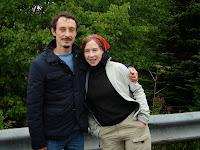9.26.13 Thursday
I’m a glass-half-full kind of guy with
the notion that maybe someone will come along with a pitcher and fill it
up. But all this rain and wind is not
filling my glass at all. Today continues
windy with light rain. We were so soaked
coming back from the fortress that the courtesy map of the grounds was like a
wet paper towel. So I thought it’s only
a “rabbit’s hop” to the park so let’s get a new one. (See I’m picking up on the
local lingo) On the way we saw a couple
who just entered the long drive into the park and they were walking in the
rain. They were from France and walked
from the cruise ship that came in sometime during the night. We gave them a ride to the administration
building and I got a new map.
 |
| The French Connection |
 |
| Louisbourg waterfront |
 |
| The fog horn for Louisbourg Harbor Light |

 |
| Louisbourg Harbor Light |
 |
| Louisbourg Fortress as seen from the lighthouse grounds |

Then Linda saw a side road that followed the coast up to Glace Bay. Even in the rain it was a nice drive. Glace Bay is the home to the Cape Breton Miner's Museum. It’s mainly an inside affair so let’s give it a try. It was very informative. I knew coal mining was hard dirty work, but after seeing how it was done and talking to Wishie, our tour guide, who was a miner since 1961, I find it hard to believe that anyone would do that kind of work. But there are those who would rather be miners than fishermen. Part of the tour included a walk down into a mine that went under the Atlantic Ocean. There are numerous mines in Nova Scotia that go out under the ocean but the last one closed in 2001. There are billions of tons of anthracite out there but the local power companies didn’t want to pay the $46 a ton so they started importing coal. Now the import coal is at $200 a ton but the local mines have been shut down. A loose-loose situation. Some of the miners were given training in other occupations such as masonry, carpentry, furniture making and had jobs for a while restoring the Louisbourg Fortress.
 |
| Wishie was our tour guide |
 |
| It would take 1 1/2 hours to go the 7 miles in a cable car under the ocean to the work area. The miners pay did not start until they were at the bottom. |
 |
| A train of 40 cars full of miners were let down the shaft by a cable |
 |
| Signals to tell the operator what was to be done with the cable cars |
 |
 |
| Later diesel locomotives moved the cars. |

 |
| Lunch boxes and canteens |

 |
| Lanterns |
 |
| "Bumpless Stretcher" |
 |
| Typical Company Housing |

 |
| Modern coal mover. Big Wheel was the pulley used to lower the elevator down the shaft. |
The rain continues, so tonight we
went back to Arm of Gold. Tomorrow the
weather is supposed to break. It looks
like a good time to do the Cabot Trail.











No comments:
Post a Comment